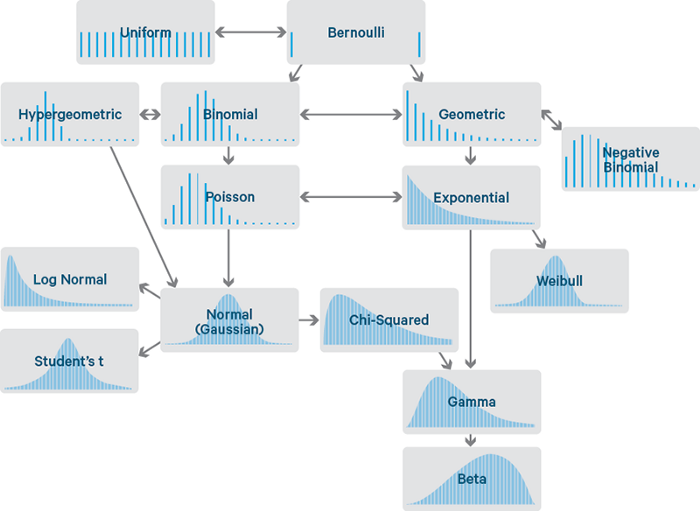
Some common probability distributions; From here
Uniform distribution (discrete) - You rolled 1 die and the probability of falling any of 1, 2, 3, 4, 5 and 6 is equal.
 (from here)
(from here)
Uniform distribution (continuous) - You sprayed some very fine powder towards an wall. For a small area on wall, the chances of falling dust on a spot on the wall is uniform.
You have a big cylinder of gas. For any unit area, number of gas molecules hitting per square cm on the inner wall per second, is seemingly to be uniform.
 from here
from here
Bernoulli distribution - Bernoulli trial is (or binomial trial) is a random experiment with exactly two possible outcomes, "success" and "failure". In such a trial, probability of success is p, probability of failure is q=1-p.
For example, in a coin toss, we can have 2 outcome- head or tail. For a fair coin, probability of head is 1/2; probability of tail is 1/2 it is one kind of Bernoulli distribution which is also uniform.
In a coin toss if the coin is unfair such as probability of getting head is 0.9 then the probability of falling a tail will be 0.1.
 Bernauli Distribution with probabilities 0.6 and 0.4; from here
Bernauli Distribution with probabilities 0.6 and 0.4; from here
Binomial distribution - If a Bernoulli trial (with 2 outcome, respectively with probabilities p and q=1-p) is run for n times; (such as if a coin is tossed for n times); there will be a little probability of getting all head, and there would be a little probability of getting all tails. A certain value of head and a certain value of tail would be maximal. This distribution is being called a binomial distribution.
 Binomial distribution with checkerboard. image modified from WP
Binomial distribution with checkerboard. image modified from WP
Poisson's distribution - example from Wikipedia: an individual keeping track of the amount of mail they receive each day may notice that they receive an average number of 4 letters per day. If mails are from independent source, then the number of pieces of mail received in a day obeys a Poisson distribution. i.e. there will be negligible chance for getting zero or 100 mail per day but a maximum of certain number (here 4) mail per day.
Similarly; suppose in an imaginary meadow e get around 10 pebbles in 1 km^2. With proportionally more area we get proportionally more pebbles. But for a certain 1 km^2 sample it is very unlikely to get 0 or 100 pebbles. probably it follows a Poisson's distribution.
According to Wikipedia, the number of decay events per second from a radioactive source, follows a Poisson's distribution.
 Poisson's distribution from Wikipedia
Poisson's distribution from Wikipedia
Normal distribution or Gaussian distribution - if n number of dies rolled simultaneously, and given that n is very big; the sum of outcome of each dies would tend to be clustered around a central value. Not too big, not too small. This distribution is being called a normal distribution or bell shaped curve.
 Sum of 2 dies, from here
Sum of 2 dies, from here

With increasing number of simultaneous dies, the distribution approaches Gaussian. From central limit theorem
Similarly, if n number of coins tossed simultaneously, and n is very large, there would be a little chance we will get to many heads or too many tails. The number of heads will centre around a certain value. That is similar to binomial distribution but the number of coin is even larger.









EstimatedDistributionfunction. $\endgroup$